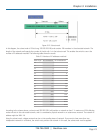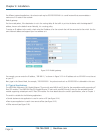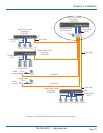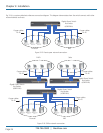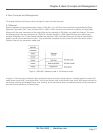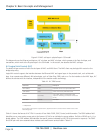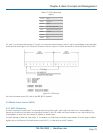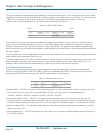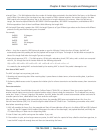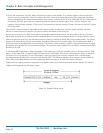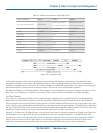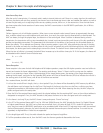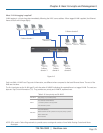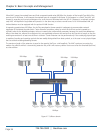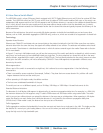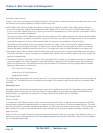
724-746-5500 | blackbox.com
Page 31
Chapter 4: Basic Concepts and Management
• Length/Type — This field indicates either the number of the data bytes contained in the data field of the frame, or the Ethernet
type of data. If the value of first two bytes is less than or equal to 1500 in decimal notation, the number of bytes in the data
field is equal to the Length/Type value, that is, this field acts as a Length indicator at this moment. When this field acts as
Length, the frame has optional fields for 802.3/802.2 SNAP encapsulation, 802.3/802.2 encapsulation, and NetWare
®
802.3
RAW encapsulation. Each of them has different fields following the Length field.
• If the Length/Type value is greater than 1500, the Length/Type acts as Type. Different type values are the frames with different
protocols running over Ethernet being sent or received.
For example,
0x0800 IP datagram
0x0806 ARP
0x0835 RARP
0x8137 IPX datagram
0x86DD IPv6
• Data — Less than or equal to 1500 bytes and greater or equal to 46 bytes. If data is less than 46 bytes, the MAC will
automatically extend the padding bits and the payload will be equal to 46 bytes. The length of the data field must equal the
value of the Length field when the Length/Type acts as Length.
• Frame check sequence (FCS) — This field contains a 32-bit cyclic redundancy check (CRC) value, and is a check sum computed
with DA, SA, through the end of the data field with the following polynomial.
G(x) = x32 + x26 + x24 + x22 + x16 + x12 + x11 + x10 + x8 + x7 + x5 + x4 + x2 + x + 1
It is created by the sending MAC and recalculated by the receiving MAC to check if the packet is damaged or not.
How does a MAC work?
The MAC sub-layer has two primary jobs to do:
1. Receiving and transmitting data. When receiving data, it parses frames to detect errors; when transmitting data, it performs
frame assembly.
2. Performing Media access control. It prepares the initiation jobs for a frame transmission and enables recovery from transmission
failure.
Frame transmission
Ethernet uses Carrier Sense Multiple Access with Collision Detect (CSMA/CD), so it detects if there is any carrier signal from
another network device running over the physical medium when a frame is ready for transmission. This is referred to as sensing
carrier, also “Listen.” If there is a signal on the medium, the MAC defers the traffic to avoid a transmission collision and waits for
a random period of time, called backoff time, then sends the traffic again.
After the frame is assembled, when transmitting the frame, the preamble (PRE) bytes are inserted and sent first, then, the
Start-of-Frame Delimiter (SFD), DA, SA and through the data field and FCS field in turn. The following summarizes what a MAC
does before transmitting a frame.
1. MAC will assemble the frame. First, the preamble and Start-of-Frame delimiter will be put in the fields of PRE and SFD, followed
by DA, SA, tag ID if tagged VLAN is applied, Ethertype or the value of the data length, and payload data field, and finally the
FCS data will be put in order into the responding fields.
2. Listen if there is any traffic running over the medium. If yes, wait.
3. If the medium is quiet, and no longer senses any carrier, the MAC waits for a period of time, called the inter-frame gap time, to
have the MAC ready with enough time and then start transmitting the frame.



